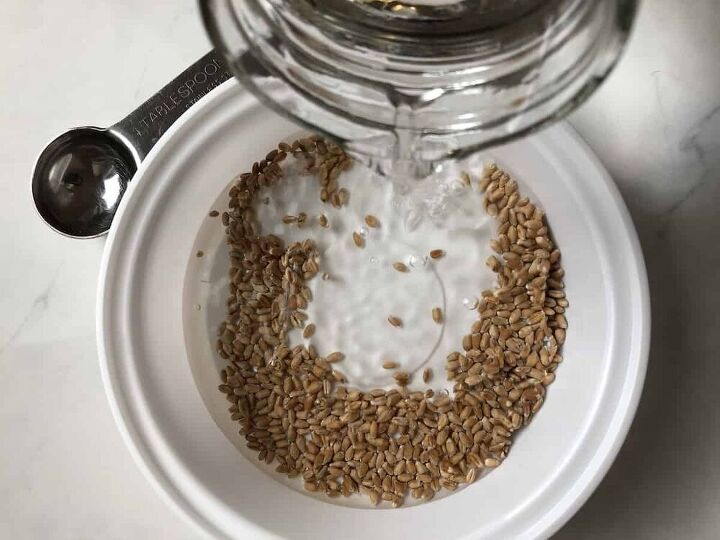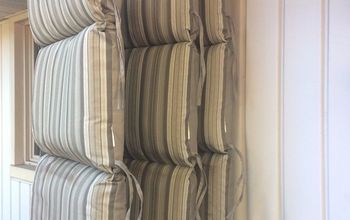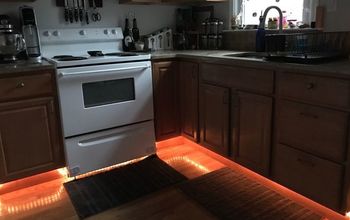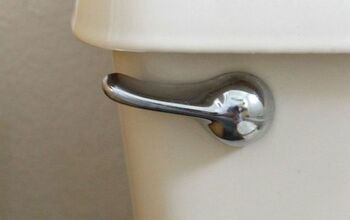🐈 🪴 How To Grow Cat Grass In A Recycled Take-Out Container 🐈

If you’re a cat parent, ensuring a comfortable, healthy, and entertaining environment is the ultimate goal for your pet. If your cat is already spoiled with tons of toys and treats, cat grass is a fun and healthy item to add to your cat’s living environment! 🐈 🪴 💖
BEFORE - Dry catgrass seeds
Step 1: Measure Out Seeds
The first step is to measure out an appropriate number of seeds for your tray. This is not an exact process. You can grow the seeds very sparsely or fill the whole area up. I like to use enough seeds so the grass is full and thick, but the roots and shoots still each have a bit of room. See the photo above, where I’ve decided on 2 Tbsp of dry wheat seeds (Hard Red Spring Wheat).
Most individual-sized take-out trays grow best with 1-2 Tbsp of dry seed. Jot down how many seeds you’ve used so you can make adjustments in the future if need be.
Step 2: Soak Seeds In Water
The next step is to pour some clean, fresh water into the tray with the seeds. Seeds for cat grass can be soaked for 6-8 hours (before planting them) to give them a kick-start on germination. Let the seeds sit submerged in the water so the moisture can soften the outer layer of the seeds and encourage sprouting.
Step 3: Drain the water out of the catgrass seeds
Remove the seeds from the tray at this point so you can add the potting soil. I like to pour the seeds and soaking water through a strainer in the sink and then use the sink tap to gently wash the soaking water off the seeds. Set aside seeds.
While 6-8 hours of soaking time is probably a good target, I have had similar success with seeds soaked for only 4 hours and with seeds soaked for 12 hours in clean fresh water.
Step 4: Prep Soil Tray
Fill the tray/container with a thin layer of potting soil. The amount of soil you use is mostly a matter of personal preference. You could put a few inches of depth in a particularly deep tray, all the way to using absolutely no potting soil at all (its finicky, but totally do-able). I used about a 1/2 inch (1 cm) depth of potting soil in the batch shown in the photos.
Here's one of my favorite potting mixes to use: https://www.liketoknow.it/ltk/3STP8zzIwqAzpRYCzI2GY3
Use your spray bottle or water vessel to moisten the potting soil. The goal is for the soil to be damp, but not wet like a mud puddle. Imagine it as a sponge that has been placed under the tap of water and then wrung out. Like the sponge, your soil should contain some moisture, but also pockets of air. Cat grass roots need immediate access to both air and water!
Step 5: Plant Cat Grass Seeds
Now that the seeds have been soaked and washed, they’re ready to be planted. Gently transfer the damp seeds from the strainer onto the surface of the soil. The seeds need to be treated with care at this point as they have delicate, tiny little buds that are the beginnings of all future growth. Be gentle with them!
Sprinkle the seeds on the soil by hand and carefully move them around if there are too many in one spot. Coverage will never be perfectly even, but it doesn’t have to be for the full-grown grass to look full and thick.
If you like, you can gently push the seeds down into the soil, but they’ll also grow perfectly well while sitting on top of the soil. In the batch pictured below, some of the seeds are mixed in with the dirt while some of them are sitting on top of the potting soil. And that’s just fine.
Step 6: Water, Cover, and Set Aside
Now that the seeds are planted, make any final adjustments like shifting the seeds around or adding a bit more water (or pouring off some water if there is too much).
At this point, the cat grass is off to a great start. Some cat-lovers like to cover the tray at this point to create a mini-greenhouse for the seeds. You can use a tray cover, cling wrap, or repurposed plastic bag. Or you can just leave the tray open to the air. Either way, you’ll be checking on the tray each morning and evening.
Find a warm, sunny spot to serve as your cat grass growing station. A well-insulated sunny windowsill works well, and light can always be improved with a mini plant light. We’re looking for somewhere cozy and bright with good air circulation.
Step 7: Check Cat Grass Twice Per Day
Whether you’ve covered your tray or not, check it twice per day (generally in the morning and in the evening). The idea is to make sure the tiny roots have access to both air and water.
The tray shouldn’t feel too light or two heavy. The soil shouldn’t be dry and it shouldn’t be muddy. Somewhere in the middle is best.
Trays that aren’t covered or are in really dry homes may need quite a bit of water added to them every 12 hours. Try not to let the soil and seeds dry out completely.
Covered trays or trays grown in more humid spots may only need a bit of water every day or two. In these environments, good air circulation is critical. Even if the tray doesn’t require watering, take off the cover or move it to a breezy spot for a bit to ensure the baby plants have access to fresh air.
STEP 8: Give to Cat & Start Next Tray
The cat grass generally grows a tiny bit each day for the first few days, and then really shoots up towards the end of the week. Cat grass can grow tall enough to use in as little as 5 days in optimal conditions, while it might take two weeks in sub-par environments. A week is a great rule-of-thumb for time to harvest for catgrass.
Most cat owners tend to plant one tray of catgrass each week per cat. For instance, Sunday might be your cat grass day. Every Sunday, you’ll soak the seeds for 6-8 hours, making sure they’re planted before you go to bed in the evening. Then kitty will have a fresh tray to enjoy during each subsequent weekend.
AFTER
Cat grass is annual cereal grass (or a mix of grasses) grown indoors in a small tray specifically for cats to enjoy. Typically cat grass is grown from barley, wheat, rye, and/or oat seeds.
Enjoyed the project?
Resources for this project:
See all materials
Comments
Join the conversation
-
 Bonnie Cornwell
on May 26, 2021
Bonnie Cornwell
on May 26, 2021

-
-
 Bonnie Cornwell
on May 26, 2021
Bonnie Cornwell
on May 26, 2021
I am going to try this and share with my friend who has 5 cats, thank you
-









































Frequently asked questions
Have a question about this project?
do the kitties eat the grass? I can imagine my kitty dumping the whole thing out and playing in the dirt! lol
Is the cat grass toxic to dogs?
Why do cats eat this grass particularly??